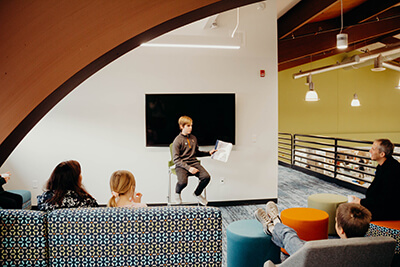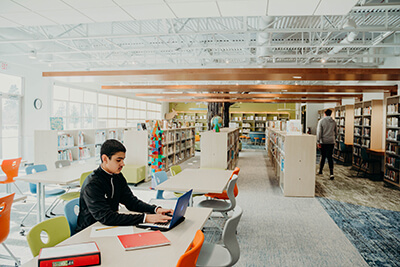How Much Do Med Schools Care About Acedemic Rigor

As expectations begin to rise in the Middle School, academic rigor also intensifies. Teachers incorporate increasingly abstract concepts delivered at a progressively faster pace. Homework becomes more formalized, study habits become solidified, and students' capacity for deep understanding is expanded.
Middle School teachers balance academic rigor (the why and the how behind every new concept) with experience-based learning, purpose, and joy. As a result, classes are engaging yet rigorous, perfect for those students seeking a more significant challenge. Rigor with purpose in the Middle School also means that learners are expected to be resourceful, organized, and adaptable. The guided lessons of early childhood give way to multistep research projects, open ended questions, and authentic assessments in grades five through eight.
Proof of academic rigor is apparent both in students' genuine excitement for solving the challenges presented in their course work and in their focused participation in the classroom. Rather than sitting in the back row, bored, disengaged, and distracted, at MPA top students in the Middle School are challenged, attentive, and actively engaged in their learning.
Rigor emerges in countless different ways. Some, like advanced classes (French III and Honors Geometry for example) are the more recognizable indicators of rigor. Other ways, like i-Term courses in coding, or prototyping workshops in the Makerspace are unique to MPA. But throughout the Middle School, rigor with purpose never means forcing top students to complete extra busywork, nor taking away support or individual attention from a teacher. Rather, rigor in the Middle School is about diving deeper and navigating abstract concepts.
Let's take a closer look at four themes of academic rigor in Middle School.
Experiential Learning
It's no accident that the Makerspace is located in the heart of the Middle School. This space is MPA's hub for experiential, hands on learning, and Middle Schoolers have it right in their front yard. One way that the Makerspace delivers academic rigor is by creating opportunities for students to resolve open ended problems as they work together to tinker, design, and prototype. Projects in the Makerspace challenge even the strongest students to become uncomfortable with unknowns and abstraction, to think theoretically, and dig deep into their vast content knowledge for answers to seemingly unsolvable questions.
So, while rigor is of course present in accelerated math and analytical writing, our curriculum also delivers it through experiential learning, tailored perfectly to 21st century students, who are being prepared for careers and lives that will certainly look much different than our world today. That's unique to MPA. Whether it's an i-Term class, the Future Cities project, or Chat With The Notables, learning in the Middle School is hands on and active, putting students in situations where finding solutions requires creativity, critical thinking, communication, and collaboration, all skills listed among Brian Miller's 6 C's of Education For The Future.
Problem Solving
 The Middle School curriculum is built on solving rigorous problems, from the Sciences to Theatre to Humanities. However, nowhere is problem solving more prevalent or rigorous than in mathematics. Middle School math teacher Dan Ethier is an expert in crafting open ended problems that require his students to apply their deep content knowledge in creative ways. Rather than giving students problems that have a clear, procedural approach, Ethier opts instead for ones where the approach is not obvious nor straight forward from the start. His students work to solve problems with multiple solutions rather than acting as human calculators and practicing only computations.
The Middle School curriculum is built on solving rigorous problems, from the Sciences to Theatre to Humanities. However, nowhere is problem solving more prevalent or rigorous than in mathematics. Middle School math teacher Dan Ethier is an expert in crafting open ended problems that require his students to apply their deep content knowledge in creative ways. Rather than giving students problems that have a clear, procedural approach, Ethier opts instead for ones where the approach is not obvious nor straight forward from the start. His students work to solve problems with multiple solutions rather than acting as human calculators and practicing only computations.
Ethier's Honors Prealgebra, Honors Algebra, and Honors Geometry courses all use Alcumus, a mastery based assessment from the Art of Problem Solving that's intended for gifted and talented students. In Alcumus, students must show concept mastery on one problem before continuing on to another, and problems become either more or less rigorous depending on a student's answer, meaning it's ideal for both gifted math learners and those who are learning at grade level.
Ethier's problem solving approach also connects academic rigor to life by incorporating real world concepts into mathematics. Whether it's learning about investing and interest, investigating exponential growth related to COVID-19, or measuring the depths of craters on the moon using trigonometry, his students find themselves solving problems that apply mathematics to real life.
Rising Expectations
 As students progress toward eighth grade, the final year before Upper School, expectations around assessment, classroom responsibility, and respectful discourse increase. It is the gentle yet firm push from teachers and classmates that prompts students to meet these growing expectations and ready themselves for the challenge and rigor of Upper School.
As students progress toward eighth grade, the final year before Upper School, expectations around assessment, classroom responsibility, and respectful discourse increase. It is the gentle yet firm push from teachers and classmates that prompts students to meet these growing expectations and ready themselves for the challenge and rigor of Upper School.
Academic rigor in the Middle School means that students are asked to show what they know in lots of different ways. From group projects to essays, multiple choice exams to public speaking presentations, students are authentically assessed in ways that push them to think deeply and creatively—far beyond rote memorization. For example, in John Milam's seventh grade Science and Design course, students are given a preserved animal and tasked with applying their knowledge of biomimicry to design a product that can be used to solve a real world problem.
With longer classes and a block schedule, Middle School students dive deeper into complex topics, and their capacity for academic endurance increases. Expectations surrounding classroom focus rise as they become responsible for fully engaging in 75 minute classes. Academic rigor means that students stay engaged, respectful, and on task, ensuring there is ample time for collaborative group work, one-on-one teacher conversations, and full-group discussion within a single class period.
Respectful Discourse
Responsibilities regarding respectful conversation and classroom dialogue grow too as rigor is increased. As humanities topics grow more challenging and multiple solutions emerge in math and science classes, differing opinions begin to surface. Academic rigor means that students are taught to embrace difference, participate in debate, and engage in civil dialogue with classmates and teachers.
This means that in the Middle School, classrooms look less like the "sage on the stage," with a teacher lecturing away, and more like the "guide on the side," with student driven dialogue and collaboration leading to deeper content knowledge. A wide variety of viewpoints and attitudes brings the opportunity for truly meaningful collaborative work, and academic rigor means that students are asked to work with peers who bring to the table differing perspectives, benefitting all learners in our diverse community.
How Much Do Med Schools Care About Acedemic Rigor
Source: https://www.moundsparkacademy.org/academics/middle-school/rigor.shtml

0 Response to "How Much Do Med Schools Care About Acedemic Rigor"
Post a Comment